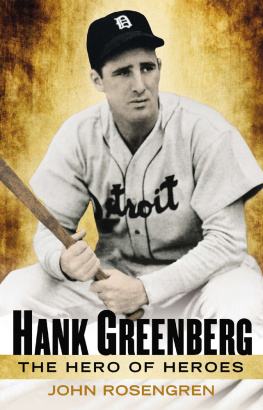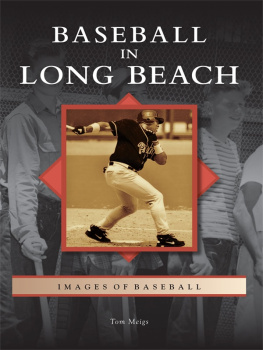By the Staff of Whos Who in Baseball and Douglas B. Lyons
An imprint of Rowman & Littlefield
Distributed by NATIONAL BOOK NETWORK
Copyright 2015 by Whos Who in Baseball Magazine Co., Inc.
All images are courtesy of Whos Who in Baseball Magazine Co., Inc.
Special thanks to the Baseball Hall of Fame, Pete Palmer, Marty Appel, Doug Lyons, Rita Halpern, Stanley Harris, Warren Sherman, Rory Slifkin, Stuart Shea, Scott Gould, Mark Arrow, Ben Harris, and all of baseballs fans and players
All rights reserved. No part of this book may be reproduced in any form or by any electronic or mechanical means, including information storage and retrieval systems, without written permission from the publisher, except by a reviewer who may quote passages in a review.
British Library Cataloguing-in-Publication Information available
Library of Congress Cataloging-in-Publication Data available
ISBN 978-1-4930-1015-8
eISBN 978-1-4930-1722-5
 The paper used in this publication meets the minimum requirements of American National Standard for Information SciencesPermanence of Paper for Printed Library Materials, ANSI/NISO Z39.48-1992.
The paper used in this publication meets the minimum requirements of American National Standard for Information SciencesPermanence of Paper for Printed Library Materials, ANSI/NISO Z39.48-1992.
CONTENTS
FOREWORD
By Marty Appel
Before baseball became a year-round, nonstop 24/7 bombardment of news, with the winter months filled with rumors, free agent signings, trades, blogs, tweets, press conferences, MLB Network, ESPN, and Tommy John surgerieswe could pause after the World Series, catch our breaths, and gently count the days until spring training.
In the really old days, people were said to sit around a hot stove and talk baseball, and the talk was often things like whos betterRuth or Cobb?!
The first sign of spring training being just around the corner was often a sighting of a handy little publication on the corner newsstand called Whos Who in Baseball . Digest size, it would catch ones eye with its distinctive red cover, and the sight of it would bring joy and hope that the new season was almost here.
It first appeared in 1912 when William Howard Taft was in the White House, and as Taft was also the first president to throw out the ceremonial first pitch of the season, the coincidence seems appropriate. At a time when the president deemed it worthwhile to christen a new season, the publisher of Baseball Magazine deemed it a good time to give the fans a guide to all the big-league players, while getting their statistical house in order.
It likely took its name from Marquiss Whos Who in America , first published in the United States in 1899, and by 1912, well established as a prestigious directory of the nations movers and shakers. To get into Whos Who in Baseball , one needed to be on a major league roster in 1911. To baseball fans, that was prestige enough.
Fans were probably delighted. By todays standards, it didnt offer muchgames played, batting average, and fielding average were all you got, and lets face it, who has ever cared much for fielding average anyway. But you had all the players alphabetically, with their height and weight and birthdate, their full name, and of course, whether they batted or threw right- or left-handed.
It ran from Babe Adams to Heinie Zimmerman, and proudly stated in the front matter, There is no book on the market that gives this informationit is absolutely the FIRST and ONLY BOOK OF ITS KIND.
It had a generic cover, sold for 30 cents, and probably didnt sell all that well, because Baseball Magazine put the idea to rest for another four years, before bringing out a 1916 edition, with Ty Cobb gracing the cover.
That 1916 edition was deemed by the publisher to really be the first edition, so that in 2015, a 100th edition was published (even if it was really the 101st).
Yes, for all the twists and turns to baseball stats, to all the movement to online presentations, to the rise and demise of The Sporting News s heftier Baseball Register Whos Who in Baseball endures.
It is comfort food for the baseball soulalways has been.
Its evolution has seen it pass through the hands of some of the legendary statisticians in the games history. It has always been there for the avid fan, the casual fan, the sportswriters and broadcasters, the team executives, and yes, even for the players.
Baseball Magazine was only four years old when they put out that 1912 edition. The magazine continued to publish until 1957, and while it never had the cachet of The Bible of Baseball like The Sporting News did, it was appreciated by fans who enjoyed offbeat stories or character studies of players. For a big event, like the opening of Yankee Stadium, they could deliver strong issues with in-depth reporting.
The 1912 attempt at stats for fans in a handy size was a noble idea, and there was no shortage of progressive thinking at the editorial desks of the magazine at 70 Fifth Avenue in New York. In fact, in 1922, their publication of The Baseball Cyclopedia , edited by Ernest Lanigan, was the first 20th-century attempt at listing all players in history.
They reached outside of their offices for the 1916 edition, engaging John J. Lawres to put it together. Lawres was what we would today call a stat-geek: a sabermetrician. Baseball statistics drew people who loved sorting numbers, and Lawres, with his 1,200 pages of personal record keeping, was the man for the job. He edited the first six editions, and even had his short autobiography in each, writing: The labor that was begun as a diversion has become little short of slavery, but I feel in my own little way that it is a pleasure to accomplish unknown a work that, in its creation, may please thousands who know neither my face, name or even existence.
Lanigan took over in 1922. Whether his tenure was brief or long is uncertain, for he was only listed for two years before the title of editor dropped from sight. But to have him associated with the book added a lot to its credibility. He is the man most responsible for the official acceptance of runs batted in as a statistic, and he later became the curator at the Baseball Hall of Fame when it opened its doors in 1939.
Remarkably, Whos Who did not include home runs as a category until 1940five years after Babe Ruths retirement. One can only imagine the editorial discussion at the Baseball Magazine offices after Ruth hit 60 home runs in 1927.
Whaddya think, should we add home runs?
It would mean resetting the columns!
But weve done that before.
Oh, everybody knows he hit 60.
Okay, let it be.
And so the 1928 edition would give the reader games, at-bats, runs, hits, stolen bases, and average. The reader would know that Babe had seven stolen bases in 1927, but not 60 home runs. Crazy.
The introduction to the book in those days made clear that it was devoted to the better known or more talented players of the two major leagues. In future years, that would expand, eventually causing the book to move from saddle stitch binding (staples) to a perfect binding (glue, with a spine). As baseball expanded, first in 196162, and then in 1969, 1977, 1993, and 1998, the book had no choice but to grow bigger and bigger. The 1962 edition was the first to exceed 500 players, and in 1969 it went over 600. Today it approaches 800. The 1952 edition had 128 pages, up from 96 the year before. In 1969, when four teams were added to the majors, the trim size of the book grew as well, up to approximately 5x8 (as it remains today), from 5x6. Photos of the players first appeared alongside their entries in 1965. For a few years in the 1970s, there was an alternate blue cover, an edition printed expressly for Scholastic Books. But red has prevailed as either the trim or the full cover for the run of the publication.



















 The paper used in this publication meets the minimum requirements of American National Standard for Information SciencesPermanence of Paper for Printed Library Materials, ANSI/NISO Z39.48-1992.
The paper used in this publication meets the minimum requirements of American National Standard for Information SciencesPermanence of Paper for Printed Library Materials, ANSI/NISO Z39.48-1992.